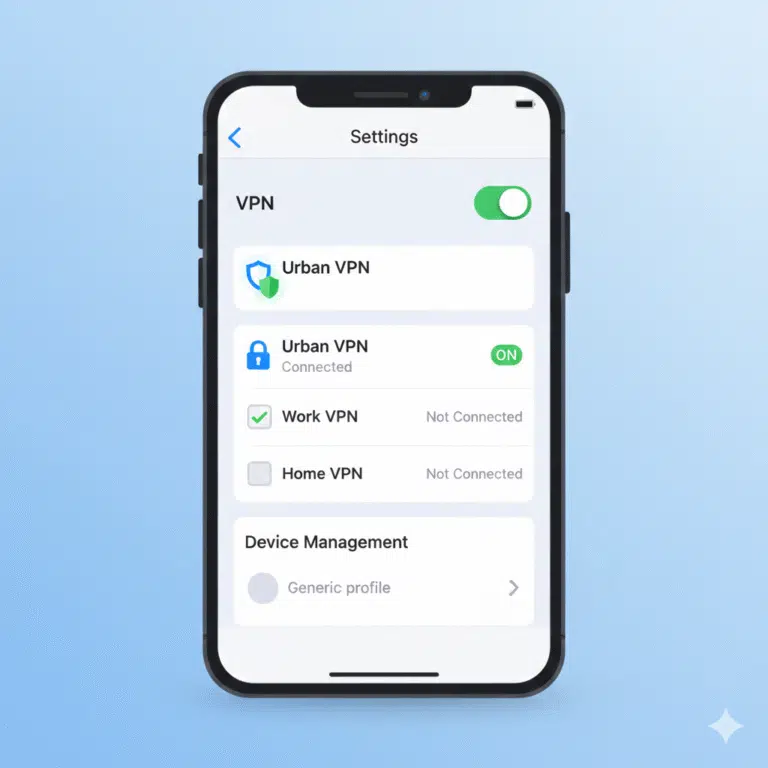In modern enterprise environments, ensuring secure and private connectivity on mobile devices is critical. This guide explores how to turn on VPN on iPhone, providing IT managers, network engineers, and cybersecurity professionals with practical steps, advanced considerations, and troubleshooting insights.
How To Turn On VPN On iPhone: Quick Steps
Activating a VPN on iOS requires navigating to the Settings app. From the main Settings menu, select General > VPN & Device Management > VPN, then toggle the desired VPN configuration to “On.” If no configuration exists, you must first install a VPN profile from either a trusted provider or an enterprise Mobile Device Management (MDM) solution. Many commercial VPN apps also allow one-tap activation directly from their application interface.
This method is standardized across most iOS 16 and iOS 17 deployments (source: TechRadar), ensuring compatibility in enterprise-managed and BYOD environments.
Which Method Should You Use: VPN App vs Manual Configuration?
Using a dedicated VPN app offers simplified management, automatic updates, and built-in protocol selection. Manual configuration is suitable for environments requiring strict compliance or custom protocol enforcement, such as IKEv2 or L2TP/IPSec. Enterprise IT teams often prefer manual setups to maintain centralized control over authentication and routing policies. Both approaches provide comparable encryption standards, but apps can streamline user experience and reduce configuration errors.
How To Set Up A VPN Manually on iPhone (IKEv2 / IPSec / L2TP)
To manually configure a VPN:
- Open Settings > General > VPN & Device Management > Add VPN Configuration.
- Select the Type: IKEv2, IPSec, or L2TP.
- Enter server information, remote ID, local ID, and authentication credentials.
- Save the profile and toggle the VPN switch to On.
Manual configuration enables enterprise-grade protocol selection and granular control over tunneling rules. Reference the official IETF specifications for protocol best practices (source: RFC 8484).
How Do You Know When Your VPN Is Active On iPhone?
The VPN icon appears in the status bar when a tunnel is established. You can also confirm connectivity via Control Center, which displays active VPN sessions. For advanced verification, IT teams can monitor traffic through endpoint logs or network monitoring tools to ensure that all data passes through the encrypted tunnel, preventing leakage of sensitive enterprise information.
Why Does My VPN Keep Turning On Or Reconnecting?
Persistent VPN reconnections often occur due to the Connect On Demand feature, enabled by default in some iOS configurations. This ensures continuous encryption but may cause unwanted reconnections if the profile is misconfigured or conflicts with network policies. Enterprise IT should verify profile settings and consult MDM logs for irregular session behavior. Additional insights are available from Cloudflare’s VPN security guide (source: Cloudflare).
Constraints and performance:
performance
- Device model: Older iPho
- iOS version: Protocol su
- ISP and network conditions: NAT or restrictive firewalls can interfere with tunnel establishment.
- Protocol choice: IKE
Benchmark testing should be performed under controlled network conditions to evaluate latency, throughput, and battery impact, particularly when deploying VPN at scale in enterprise environments.
Can You Automate VPN On/Off With Shortcuts or Focus Mode?
Advanced users can leverage iOS Shortcuts or Focus Mode automations to toggle VPN based on location, time, or network type. For example, VPN activation can be triggered automatically when connecting to untrusted Wi-Fi networks. This ensures consistent encryption without manual intervention and enhances endpoint security compliance. Leveraging these automations can reduce human error and maintain operational security standards.
How To Turn Off And Remove A VPN Configuration Completely
To deactivate or remove a VPN:
- Navigate to Settings > General > VPN & Device Management.
- Select the active VPN configuration and toggle Off, then tap Delete VPN.
- For enterprise-managed devices, MDM administrators may remotely remove profiles or enforce disconnect policies.
This step is critical for troubleshooting, resolving network conflicts, or transitioning to alternative VPN solutions, such as NordVPN or AirVPN for advanced enterprise deployments.
Troubleshooting Connectivity and Validation
Network engineers should verify IP changes and tunnel integrity using external tools. Confirm DNS resolution and perform a packet inspection if allowed. Misconfigurations or outdated certificates may prevent successful VPN connections. Maintaining updated VPN apps and monitoring iOS system logs ensures operational reliability in mission-critical environments (source: Kaspersky).
By following this guide, IT teams and cybersecurity professionals can confidently implement, monitor, and troubleshoot VPN connectivity, ensuring compliance and secure network access. Understanding how to turn on VPN on iPhone is essential for maintaining endpoint privacy, enforcing corporate policies, and minimizing exposure to cyber threats.



